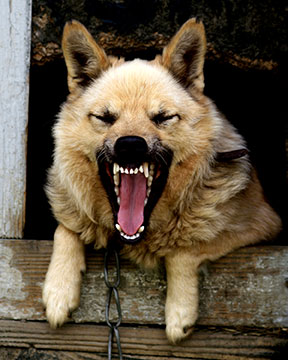McAllen Dog Bite Lawyer | McAllen Dog Mauling Lawsuit | McAllen Dog Attack Attorney
Hidalgo County Dog Bite Accident Attorney
 Dangerous Dog Facts:
Dangerous Dog Facts:
- An estimated 4.5 million people are bitten by dogs each year;
- Approximately 334,000 people are admitted to US emergency rooms annually with dog bite-associated injuries, and another 466,000 are seen in other medical settings;
- An unknown number of other people who have been bitten do not sustain injuries deemed serious enough to require medical attention;
- Almost half of all persons bitten are children younger than 12 years old; and
- People more than 70 years old comprise 10% of those bitten and 20% of those killed.
According to Zoonosis Control Division of the Texas Department of Health, domesticated dogs comprise most the dog bites in any given year. Even more shocking, Texas was the leader in dog bite fatalities in 2007, with seven fatalities stemming from dog bites that year alone. There is a regional Zoonosis office in Harlingen located at Texas Department of State Health Services, Zoonosis Control, 601 West Sesame Drive, Harlingen, Texas 78550, (956) 444-3212 for all of your needs and questions.
Responsible Dog Ownership in McAllen Definitely Can Reduce McAllen Dog Bites
As so many things in life, dog bites can be reduced by what happens in the home. A dog is not always the one to blame in the instance of a dog attack or dog bite injury. Many owners use their dogs for illegal dog fights and these dogs are victimized every bit as much as the victims of their attacks, and they too are often severely injured or even killed in dog fighting rings as they fight for their lives. Negligent and abusive dog owners should be held liable for their actions. A decision to be a responsible dog is a personal decision and one that requires responsibility. There are many places in and around McAllen, Texas to have your dog trained for obedience. Dog owners are also able to take their dog to an area designated for dogs to play. Dog parks are there so that the owner can take their dog to an area where they can run around and play in an fenced-in and safe place. Dog parks are a responsible place to take your pet to ensure that when they are running off their leash that they will not run away from you and/or cause harm to a person or another animal. Some Dog Training Facilities and Dog Park locations in the General McAllen Area include:
|
Dog Obedience Inc |
Happy Dog Training |
|
Catherine B. Stillman Dog Park |
Dogs should be trained and any sense of aggressive behavior exhibited by a dog should be immediately attended to by the pet owner in order to avoid a future incident. What it boils down to is that if you or a loved one have been bitten, attacked, maimed, or killed by a dog or other animal, you should be entitled to some degree of compensation from the animal’s owner or handler. Contact one of the experienced McAllen dog bite lawyers above for a consultation regarding your claim.
Texas’s “One Bite” Rule & Dog Bite Claims Based on Negligence
Texas follows the arcane “one bite rule.” This means that a pet owner is liable when:
- the owner knew that the dog had bitten someone before or had a “dangerous propensity” for biting;
- the bite was caused by the negligence of the person handling the dog;
- the bite was caused by a violation of a leash law, prohibition against dogs trespassing or running at large, or a similar animal control law; or,
- the bite injury was caused intentionally by the owner or person handling the dog.
 When it cannot be proved that the dog’s owner or handler knew of the dog’s propensity to bite, negligence can form the basis of a claim. An example of a negligence-based claim could occur when the owner of a dog whose breed is notorious for its violent propensities — such as a pit bull, Rottweiler, or German Shepherd — allows their dog to run loose in a children’s park or other public area without supervision. The dog’s owner will be held liable based on negligence if the dog bites a child in the park.
When it cannot be proved that the dog’s owner or handler knew of the dog’s propensity to bite, negligence can form the basis of a claim. An example of a negligence-based claim could occur when the owner of a dog whose breed is notorious for its violent propensities — such as a pit bull, Rottweiler, or German Shepherd — allows their dog to run loose in a children’s park or other public area without supervision. The dog’s owner will be held liable based on negligence if the dog bites a child in the park.
However, a person does not have to be the dog’s owner to be held liable for a bite victim’s injuries. A child bitten at a day care facility for dogs could, through the child’s parents, make a claim against the pet care center, even though the dog was owned by a third party who was absent at the time of the bite. If you or a loved one has been the victim of a dog bite, you should contact a McAllen dog bite attorney to pursue your personal injury claims. Even if the dog has no prior history of aggression and has never bitten anyone before, Texas’s “one bite rule” may allow a McAllen dog bite injury lawyer to fight your claim successfully, and you deserve compensation for your injuries.
McAllen Negligence Per Se Dog Bite Lawyer
When a statute or ordinance is violated and the violation leads to an injury, this is called negligence per se.
Negligence per se is frequently found in cases of dog bites, dog maulings, and dog attacks, often resulting from a violation of:
- leash laws;
- dog trespass laws; or,
- no “free-run” laws.
Usually, these types of dog control laws and ordinances are only found in large Texas cities; however, McAllen has an ordinance requiring that dogs be "restrained" at all times. Furthermore, McAllen requires that all dogs over four months of age be licensed with the city officials. If you or a loved one has been bitten or mauled by a dog running loose in violation of the law of McAllen or Hidalgo County, you should contact a local McAllen dog bite attorney immediately.
Lillian’s Law (H.B. 1355)
The so-called “Lillian Stiles Law,” sponsored by Senator Eliot Shapleigh and passed in 2007, increases the jail time for owners who fail to secure their dogs in a reasonable manner, resulting in serious bodily injury or death to another. Under the law, a dog owner will be charged with a third-degree felony if their dog causes serious bodily injury to a victim during an unprovoked attack. A third-degree felony is punishable by 2-10 years of prison time as well as a potential fine of up to $10,000. If the victim dies from an unprovoked dog attack, H.B. 1355 would impose a charge of second-degree felony, punishable by up to 20 years in prison. Click here for more information on the passage of Lillian’s Law,
Texas still allows a dog to be chained up, which is not only bad policy, but also dangerous to children and others who are routinely attacked by dogs that have been chained. Lillian’s law helps protect McAllen residents from dogs that attack when not reasonably secured and allows McAllen dog bite lawyers to sue the dog owners despite lack of previous history of aggression or any provocation from the injury victim. Call a McAllen dog bite lawyer today.
Some of Texas' Laws on Dog Bites
Some of the laws are found in the Texas Health & Safety Code, Title 10, Chapter 822 Regulation of Animals:
- Subchapter A General Provisions; Dogs That Attack Persons or Are a Danger to Persons;
-
Subchapter D Dangerous Dogs;
- 822.041. Definitions;
- 822.042. Requirements for Owner of Dangerous Dog;
- 822.0421. Determination That Dog is Dangerous;
- 822.0422. Reporting of Incident in Certain Counties and Municipalities;
- 822.0423. Hearing;
- 822.043. Registration;
- 822.044. Attack by Dangerous Dog;
- 822.045. Violations;
- 822.046. Defense; and
- 822.047. Local Regulation of Dangerous Dogs
City of McAllen Dangerous dog Laws
DIVISION 1. - GENERALLY
Sec. 14-36. - Tethering and confinement.
Sec. 14-37. - Dogs running at large (leash law).
Sec. 14-38. - Confinement during rabies emergency.
Sec. 14-40. - Maintenance of premises where dogs and cats kept.
Sec. 14-41. - Unvaccinated dogs or cats are a nuisance.
Secs. 14-42—14-50. - Reserved.
Sec. 14-36. - Tethering and confinement.
(a) It is unlawful to tether a dog:
(1) Using any device that is directly attached to its neck, but instead via a tying device attached to a properly fitted collar or harness made of leather or nylon, and not of the choker type; this does not prohibit the proper use of choker collars in the training of dogs;
(2) Using a collar exceeding one and one-half inches wide for any dog weighing less than 60 pounds, or using a collar exceeding two inches in width for dogs weighing 60 pounds or more;
(3) Except by using a tying device at least ten feet in length or five times the dog's length, whichever is longer, with a swivel device on the anchor and collar end to prevent tangling and:
a. Made of 3/16th-inch links of a minimum grade 30 with a load limit of 800 pounds for dogs that weigh between 30 and 80 pounds, or
b. Made of one-quarter-inch links of a minimum grade 30 with a load limit of 1,500 pounds for dogs that weigh from 80 pounds and up to 200 pounds.
(4) Using a device that weighs more than one-eighth-inch of the dog's body weight;
(5) In any manner that allows it, or any part of the tying device by which it is tethered, to go into, upon or over any sidewalk, alley, street, or any property not belonging to the dog's owner;
(6) To any lamppost, light pole, utility pole, awning post, tree, fence, hydrant, shrubbery, or other object belonging to another person without the consent of the owner of the object to which the animal is to be tethered;
(7) If on its owner's property, for more than four hours per day, and only if it has access to water and shelter at all times is, and the owner or a duly authorized person that is familiar with dog handling, their habits and behavior, is on the premises and within its view and a reasonable distance therefrom; or
(8) If anywhere other than its owner's property, for more than ten minutes, and only if it is in a safe place and the owner, or a duly authorized person that is familiar with dog handling, their habits and behavior, is never out of sight of the dog and never more than 50 feet away.
(b) The confinement of any vicious animal shall be secure, whether indoors or outdoors. If outdoors, the vicious animal shall be confined in an enclosed and locked kennel. Animals that are not vicious animals may be tethered or kenneled when outside any structure on their owner's premises, but are not required to be thus restrained if reasonable measures are taken to maintain the animal within the owner's premises, such as a fenced or adequately secured backyard. Kennels, whether indoors or outdoors, must be large enough for the animal to comfortably have shelter from the elements, provide at all times access to shade and water, allow a reasonable amount of space for movement, and a place to eliminate body waste. Kennels must have minimum dimensions of five feet by ten feet and must have secure sides and, if outdoors, a secure top attached to the sides in order to make it escape proof. If a concrete slab floor or patio block floor over sand is not provided for an outdoor kennel, the bottom must be wire fencing or similar material that is secured to the sides, and otherwise the sides must be embedded into the ground no less than two feet. All kennels must be adequately lighted and kept clean and sanitary. The animal shall be taken out of the kennel daily for training, playtime, exercise, and attention.

(Ord. No. 2010-25, § I, 4-26-10)
Editor's note—
Ord. No. 2010-25, § I, adopted Apr. 26, 2010, deleted the former § 14-36, and enacted a new § 14-36 as set out herein. The former § 14-36 pertained to definitions and derived from the Code of 1966, § 5-20; Ord. No. 2004-50, § 1, 6-28-04.
Sec. 14-37. - Dogs running at large (leash law).
It shall be unlawful to allow any dog to run at large within the city. The chief of police or departmental designee is hereby granted the authority to pick up and cause to be impounded any dog found running at large in the city. The impoundment notice and hearing procedures of sections 14-86 and 14-87 shall apply in the case of any such dog.
(Code 1966, § 5-21; Ord. No. 2004-50, § 1, 6-28-04; Ord. No. 2010-25, § I, 4-26-10)
Sec. 14-38. - Confinement during rabies emergency.
The chief of police, whenever he may detect danger from hydrophobia, shall request that the mayor issue an emergency proclamation requiring all dogs and/or other affected animals to be properly confined as required under section 14-10, or securely muzzled. If such proclamation is issued, it shall be unlawful for the owner of any affected animal to fail to comply with such proclamation. Such proclamation shall be published and broadcast for public dissemination.
(Code 1966, § 5-22; Ord. No. 2004-50, § 1, 6-28-04)
Cross reference— Health director, § 2-251 et seq.; health and sanitation, ch. 54.
Sec. 14-39. - Barking dogs.
It shall be unlawful to keep any dog in the city which by loud, frequent or habitual barking or howling shall cause annoyance and disturb the peace and quiet of an ordinary normal person.
(Code 1966, § 5-23; Ord. No. 2010-25, § I, 4-26-10)
Cross reference— Nuisances, § 46-26 et seq.; noise, § 46-141 et seq.
Sec. 14-40. - Maintenance of premises where dogs and cats kept.
Every person keeping any dog or cat in the city shall maintain the area used or occupied by such animal in a sanitary manner at all times and such area shall be kept free of offensive odors, flies, rodents and other pests.
(Code 1966, § 5-24)
Sec. 14-41. - Unvaccinated dogs or cats are a nuisance.
When not confined on the owner's premises, any dog or cat in or within 5,000 feet of the corporate limits of the city, except where such distance lies in an incorporated area of another city, that is found without a current tag issued as required under division 2 hereof, shall be rebuttably presumed to be unvaccinated and is hereby declared to be a nuisance. The chief of police or departmental designee is hereby authorized to impound any such dog or cat. The owner shall be notified of the impoundment in writing in a manner similar to how it is provided in section 14-86. Ownership of the animal may be rebuttably presumed in a manner similar to how it is provided in subsection 14-82(b). Such animal may not be released unless its owner furnishes proof of vaccination and licensing or shall cause the animal to be vaccinated and licensed. If within five days of service of the notice the animal's owner does not claim such animal and fully comply with the requirements of this division then the animal may be humanely disposed of in accordance with the procedures of the chief of police or departmental designee.
(Code 1966, § 5-25; Ord. No. 2003-30, § 1, 4-28-03; Ord. No. 2004-50, § 1, 6-28-04; Ord. No. 2010-25, § I, 4-26-10)
Editor's note—
Ord. No. 2010-25, § I, adopted Apr. 26, 2010, changed the title of § 14-41 from unvaccinated dogs or cats to unvaccinated dogs or cats are a nuisance.
Secs. 14-42—14-50. - Reserved
Family Bystander Mental Anguish Claims
 Texas recognizes the right of bystanders to recover damages for mental anguish caused by witnessing an accident, with the following limitations: the bystander must be a parent or child of the victim and the victim must have been killed or severely injured in the animal attack or mauling. Therefore, if you have witnessed a close family member mauled or bitten by a dog, you may want to pursue legal action on behalf of the injury victim as well as your own claims for witnessing such a horrific event. Contact a McAllen dog bite lawyer today to discuss bystander and mental anguish claims.
Texas recognizes the right of bystanders to recover damages for mental anguish caused by witnessing an accident, with the following limitations: the bystander must be a parent or child of the victim and the victim must have been killed or severely injured in the animal attack or mauling. Therefore, if you have witnessed a close family member mauled or bitten by a dog, you may want to pursue legal action on behalf of the injury victim as well as your own claims for witnessing such a horrific event. Contact a McAllen dog bite lawyer today to discuss bystander and mental anguish claims.
Negligence Based on Failure to Stop an Attack
A Texas dog owner owes a duty to attempt to stop his dog from attacking a person after the attack has begun. This is a civil duty, meaning that the McAllen dog bite victim can sue for monetary damages if the dog owner does not attempt to stop the attack.
If you or a loved one have been bitten or mauled by a dangerous dog in McAllen or Hidalgo County, TX, please contact one of the experienced McAllen dog bite injury lawyers listed on this page.
What Should You Do if You Have Been Bitten by a Dog?
- Make every attempt to keep the animal in sight, find its owner, and obtain the owner’s contact information, preferably verified by their photo ID.
- Immediately wash the wound out with soap and warm water.
- Make sure that you are up to date on your tetanus shots.
- Seek the help of a physician or visit a local hospital.
- Report the bite to the McAllen Planning and Development Services Department (contact information below).
- Seek the help of a McAllen dog bite attorney, if necessary, and maintain copies of all medical records and other relevant evidence.
|
For more information on dog bites and their victims, visit DogsBite.org |
Dog Bite Reporting:
If you would like to report a McAllen area or Hidalgo County dog bite or ask other questions pertaining to veterinary public health, do not hesitate to contact the McAllen Planning and Development Services Department office at: |
Animal Training:
A variety of animal training classes and services are offered by the
Upper Valley Humane Society
|
|
Contact one of the experienced McAllen dog bite lawyers above for a consultation regarding your claim. |
Personal Injury Attorneys Serve McAllen and Surrounding Cities
Serving clients throughout Southern Texas, including Alamo, Alton, Citrus City, Combes, Doffing, Donna, Doolitte, Edcouch, Edinburg, Elsa, Granjeno, Harlingen, Hidalgo, La Horna, La Joya, La Villa, Lopezville, Lull, McAllen, Mercedes, Mission, Olivarez, Palmhurst, Palmview, Pharr, Progreso, Raymondville, San Juan, Sullivan City, Weslaco and other communities in Hidalgo County.
If you or a loved one has suffered an injury, please contact one of the experienced Hidalgo County dog bite lawyers listed on this page.
